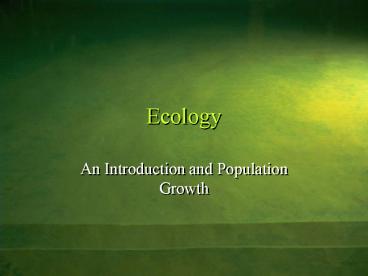Ecology PowerPoint PPT Presentation
Title: Ecology
1
Ecology
- An Introduction and Population Growth
2
Ecology
- Ecology is the science that deals with the
interrelationships among living things and their
environment. - The science deals with words like ecosystem,
community and population
3
Ecology
- Lets recall the definitions of these words.
- Ecosystem a complex, interrelated network of
living organisms and their nonliving
surroundings. - Community interacting populations.
- Population consists of all the members of a
particular species. - Individual is the single organism.
4
Ecology
- When studying ecology we are studying the
environment, but it is important to specify what
parts of the environment. - Abiotic non-living component
- Biotic living component
5
Populations
- Studies have shown that many populations remain
stable over time but there are examples of growth
and decline. - The factors that control this are
- Births, deaths, and migration
6
Populations
- Organisms can join a population through
- Immigration (migration in)
- Birth
- Oganisms can leave a population through
- Emigration (migration out)
- Death
7
Populations
- Thus simply a populations change can be difined
as - Population Change (births-deaths)
(immigrants-emigrants) - Because generally migration plays a minor roll in
population size whe can discuss the factors
determining ultimate size of the population
without them
8
Populations
- This final size is the result of a balance
between two major opposing factors - Biotic Potential or the maximum rate at which
the population could increase, assuming ideal
conditions allowing a maximum birth rate and
minimum death rate. - Environmental Resistence all living and non
living environmental factors working against
providing these ideal conditions
9
Populations
- Population size is a function of birth rate,
death rate, and the number of individuals in the
original poplulation. - Growth Rate Birth Rate Death Rate
- Births per 1000
- Deaths per 1000
- Growth Rate
- Eg.
10
Populations
- Population growth can then be defined as
- r or growth rate N or number of original ind.
- If growth rate is constant this equation become
exponential.
11
Populations
- Exponential Growth the populations grows
(during a given time period) by a fixed
percentage of its size at the beginning of that
time period. - Eg. Arithmatic v. Exponential
- J - curve
12
Human Population Growth
13
Populations
- Some of the factors affecting the biotic
potential of a particular species are (,-) Eg. - The age at which the average individual first
reproduces - The average frequency with which reproduction
occurs - The average number of offspring produced each
time - The reproductive life span of the average
organism - The average death rate under ideal conditions
14
Populations
- Exponential growth can often lead to boom and
bust cycles. - What could cause these boom and bust cycles?
- Exotic Species?
15
Populations
- Exponential growth carries with it the seeds of
its own destruction. - Increase competition
- Predators
- Parasites and disease
- Stress
- S-curves around equilibriums
16
Populations
- Populations ussually stabalize at or below their
carrying capacity. - Carrying capacity is the maximum size of a
given population of organisms that a particular
area can support indefinitely.
17
Populations
- The carrying capacity is controlled mainly by two
types of resources - Renewable resources, such as nutrients, water,
and light, that are replenished by natural
processes - Nonrenewable resources such as suitable nesting
or denning areas
18
Populations
- Organisms will die if demads on renewable
resources such as food, water,a dn light are too
high
19
Populations
- In nature, environmental resistance maintains
populations at or below the carrying capacity of
the environment. This is done through two
factors - Density-independent factors limiting population
size regardless of the density - Density-dependent factors increasingly
effective as the population density increases
20
Populations
- Density Independent Factors
- Natural Events (hurricanes, droughts, floods and
fire) - Weather (seasonal reproduction limit)
- Not reaching carrying capacity
- Boom and bust cycles
- Human Activities
- Pesticides and pollutants
- Habitat destruction
21
Populations
- Density Dependent Factors which affect long lived
species the most - Predation
- Competition with in the species or with members
of other species - Parasitism
22
Density Dependent Factors
- Predators and Parasites
- Both of these processes involve one organism
feeding on another and harming it in the process
(not necessarily in the case of parasitism) - Predator Prey
- Parasite Host
23
Density Dependent Factors
- Increase Prey?
- Increase Predator?
- Population Cycles?
24
Density Dependent Factors
- Parasites slow work?
- Limitted mobility?
- Population density?
- Effect predation also?
25
Competition for Resources
- Competition the interaction among individuals
who attempt to utilize a limited resource, limits
population size in a density-dependent manner
26
Competition for Resources
- Interspecific competition?
- Intraspecific competition?
- Scramble competition? (seed dispersal)
- Contest competition? (social and chemical
interations, territory)
27
Distribution of Populations
- Clumped
- Uniform
- Random

